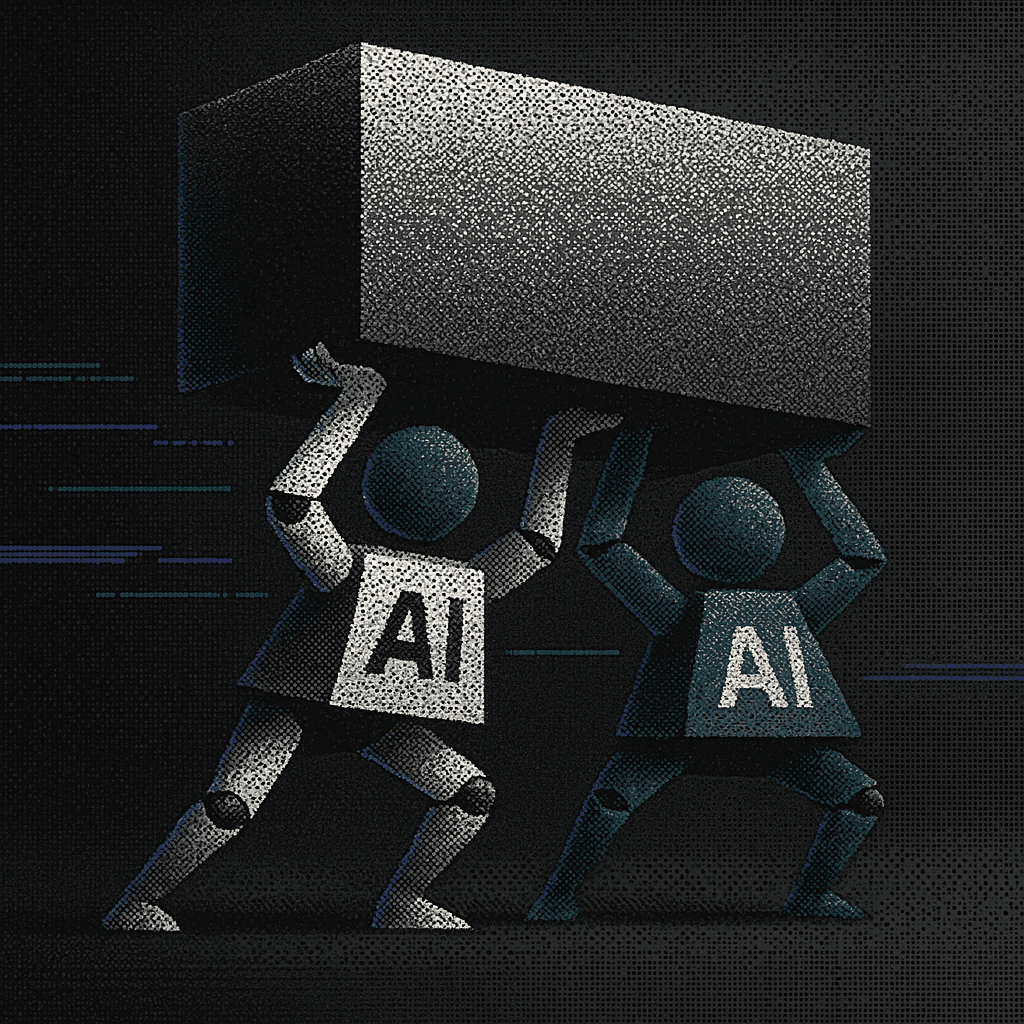
Best AI Tools for Editing Large Code Files: Enterprise Developer Guide
August 6, 2025
TL;DR: File size isn't the real challenge in AI-powered code editing, system understanding is. While most AI coding tools boast about handling massive token windows, production systems break when changes cascade through interconnected files across repositories. Tools like ChatGPT with Deep Research and Claude can process 100,000+ word files, while enterprise solutions like Augment Code provide system-level dependency mapping. Success depends on cross-repository intelligence, impact prediction, and comprehensive dependency analysis rather than raw file size handling capabilities.
Friday, 5:42 p.m. A seemingly harmless pull request touches a single Java file, 50,163 lines long, last reviewed three years ago. The change looks innocent: update a logging flag, ship the hot-fix, head home. Ten minutes after deployment, PagerDuty explodes. That flag cascades through 147 other files across 23 services. Customer-facing APIs timeout, financial reports fail, and weekend plans evaporate.
The culprit isn't the file's size. It's the invisible threads connecting that file to the rest of the system. Rename one enum, miss a reflection-based lookup in a different repository, and production collapses. Yet most AI coding tools still market themselves by bragging about token limits and context windows. According to recent analysis, tools like Copilot and Tabnine advertise massive context windows, but they're still chunking code to satisfy model limits, inevitably losing global context and missing cross-file dependencies.
This creates a dangerous disconnect between editing files and understanding systems. File-focused AI can autocomplete within massive files but won't warn that toggling a boolean affects feature-flag logic across twelve microservices. The following analysis separates marketing hype from production reality, revealing why file size is irrelevant and what evaluation criteria actually predict whether an AI assistant protects or gambles with your deployments.
1. Why File Size Misses the Point in AI Code Editing
Most AI coding tools showcase processing 20,000-line files in demonstrations that look impressive but miss the real problem. Production systems don't break because single files are too big. They break when changing three lines cascades through dozens of interconnected files across multiple repositories.
Consider renaming getUserId() to getId(). In the editor, it's simple refactoring. In production, it ripples through 147 call sites, reflection rules, YAML configurations, and cron jobs expecting the old method signature. The 3 a.m. bug report reveals payments stopped processing because of a method name buried in mobile SDK configurations.
The Context Window Limitation
Research shows that large files often exceed AI models' context windows, forcing systems to "chunk" code into segments. This leads to:
- Missed dependencies outside the current chunk
- Incongruent edits where AI lacks the full picture
- Silent breakage in production when changes affect unseen code
Traditional AI tools can't see these connections. Transformer models hit token limits and chunk code into processable slices. This works for autocomplete suggestions but fails when changes affect files outside the context window.
The enterprise challenge isn't line count but dependency discovery. Tools understanding only individual files provide quick wins like typo fixes and docstring generation while leaving teams blind to the hidden networks of database schemas, feature flags, and service contracts keeping systems operational.
2. Three Levels of AI Code Understanding
Enterprise AI tools operate at three distinct capability levels, each offering fundamentally different approaches to code comprehension and risk profiles.
File-Level Editing Tools
These tools focus on individual files currently open in editors. GitHub Copilot, Cursor, and Tabnine excel at:
- Instant autocomplete within token-sized windows
- Docstring generation for individual functions
- Isolated refactoring without cross-file awareness
- Syntax correction and formatting
Perfect for prototyping and well-understood code, but dangerous for production systems where changes ripple across service boundaries.
Repository-Level Static Analysis
These tools expand scope to entire repositories or modules, understanding:
- Symbol graphs and type hierarchies
- Lint rules and coding standards
- Bulk find-and-replace operations
- Modernization suggestions within repository boundaries
However, they stop at repository boundaries. Cross-repository reflection metadata remains invisible, creating false confidence when real breakage waits in external services.
System-Level Context Engines
These tools comprehensively map entire organizations, building semantic graphs spanning:
- Microservices and their interdependencies
- Database schemas and query patterns
- CI scripts and deployment configurations
- Documentation and API contracts
Tools like Augment Code index hundreds of thousands of files across repositories, enabling questions like "If I change getUserId() to getId(), what breaks?"
3. Real-World Scenarios That Expose Tool Limitations
Database Schema Changes Gone Wrong
Renaming user_id to account_id in the main users table appears straightforward. File-focused editors generate clean migration syntax but miss:
- 73 SQL queries scattered across repositories
- Bash scripts expecting the old column name
- Test fixtures with hard-coded field names
- **Data pipeline jobs** in separate projects
System-level tools surface every column reference, enabling coordinated changes across the entire ecosystem.
API Method Rename Disasters
getUserId() becomes getId() in what seems like a simple cleanup. File editors update method declarations but miss:
- Reflection strings in configuration files
- YAML configurations with method references
- JSON contracts for API documentation
- Mobile clients with hard-coded method names
One missed reference crashes 23 services during Friday deployments.
Microservice Extraction Nightmares
Splitting billing logic from monoliths reveals the biggest gap between file editing and system understanding. File editors copy code but miss:
- Environment variables in Helm charts
- IAM policies in Terraform configurations
- Kafka topic ACLs shared with other services
- Health check endpoints in monitoring systems
4. AI Tools Comparison: File Size vs System Understanding
According to recent analysis, here's how leading tools handle large file editing:
Text-Based AI Editors
ChatGPT with Deep Research
- File capacity: 100,000+ words
- Strengths: Comprehensive fact-checking, citation formatting, deep content analysis
- Limitations: Limited document formatting, no direct file system access
Claude (Anthropic)
- File capacity: Novel-length manuscripts
- Strengths: Largest context window, strong privacy focus
- Best for: Enterprise teams requiring confidential code analysis
editGPT
- File capacity: 200,000 words/month (Pro tier)
- Strengths: Word document integration, tracked changes
- Best for: Teams needing seamless workflow integration
Code-Specific AI Tools
Adobe Premiere Pro with Sensei
- Performance: Handles feature-length 4K+ projects
- Strengths: Real-time processing, GPU acceleration
- Limitations: High system requirements, subscription cost
DaVinci Resolve with Neural Engine
- Performance: Superior batch post-production capabilities
- Strengths: One-time purchase, colorist-grade tools
- Best for: Professional video editing workflows
5. Technical Requirements for Large File AI Editing
Industry research identifies critical technical requirements:
Computational Resources
- High RAM for processing large context windows
- Robust CPUs/GPUs for inference speed
- Cloud infrastructure for enterprise-scale indexing
Context Management
- Fixed context windows limit visibility to code portions
- Memory limitations restrict multi-file understanding
- Token constraints force chunking strategies
Integration Requirements
- IDE compatibility with development environments
- Version control system integration
- CI/CD pipeline connectivity
- Security controls for enterprise deployment
6. Common Implementation Pitfalls and Solutions
The Local Success Trap
Problem: Accepting AI-generated patches that compile and pass unit tests while staging environments explode due to renamed methods referenced in YAML configurations.
Solution: Implement comprehensive cross-repository testing and dependency analysis before accepting changes.
The Token Window Shuffle
Problem: Models chunking 10,000-line services into sliding windows rewrite sections while quietly deleting validation branches beyond visible context.
Solution: Use tools with larger context windows or system-level understanding capabilities.
The Confidence Catastrophe
Problem: Perfect autocomplete streaks build dangerous trust leading to merged suggestions that silently change critical comparisons.
Solution: Maintain human code review practices and automated testing regardless of AI performance.
7. Best Practices for Enterprise AI Code Editing
Based on developer feedback and industry analysis:
Technical Best Practices
- Hybrid Edit Application Systems: Combine AI-generated change descriptions with context-aware tool logic
- Incremental Changes: Restrict edit scope to explicitly marked code sections
- System-Wide Impact Analysis: Use dependency graphs and static analysis before applying changes
- Feedback-Driven Correction: Monitor AI edit results with rollback capabilities
Organizational Best Practices
- Mandatory Manual Review: All AI-driven changes require human code review
- Gradual Rollout: Implement AI editing in limited feature branches first
- Continuous Integration Testing: Test immediately after large-file or cross-file edits
- Developer Education: Train teams on AI capabilities and limitations
8. Security and Compliance Considerations
File editors present specific security challenges around snippet caching and training data usage. Essential questions include whether vendors permanently store pasted code, restrict model training on proprietary code, and provide on-premises deployment options.
Context engines raise different concerns:
- Repository indexing requires understanding of storage encryption
- Cross-repository access needs proper permission controls
- Production data paths must comply with GDPR, HIPAA regulations
Decision frameworks should start with non-negotiables:
- SOC 2 Type II compliance
- Customer-managed encryption keys
- Region-locking requirements
9. Cost Analysis and ROI Metrics
File-focused tools appear cost-effective until first production rollbacks reveal hidden expenses. MIT Sloan research shows that when autocomplete assistants rename methods locally while missing 47 references across repositories, costs appear as debugging hours rather than subscription fees.
Emergency weekend outages involving three senior engineers cost $48,000 in response time alone, not including customer impact or delayed features.
Context-aware engines change this mathematics by reducing time-to-market and post-deployment failures by up to 60%.
10. Implementation Roadmap for Enterprise Teams
Month 1: Foundation
- Comprehensive repository inventory
- Dependency scanning and risk assessments
- Security evaluation
- Controlled proof-of-concept
Month 2: Controlled Piloting
- Sandbox indexing
- First automated changes
- CI integration
- Velocity measurement
Month 3: Production Readiness
- Cross-service indexing with SOC 2 controls
- Ticketing system integration
- Shadow deployments
- Executive reporting on rollback reduction
11. Future of AI Large File Editing
Emerging trends in AI code editing include:
Agentic Development Environments (ADEs)
- Multi-agent systems handling autonomous editing tasks
- Workflow automation across entire project lifecycles
- Real-time dependency mapping for enterprise codebases
Hybrid AI Models
- Generative + symbolic AI combinations for accuracy
- Security-focused models minimizing vulnerabilities
- Domain-specific training for enterprise requirements
Advanced Context Management
- Retrieval systems beyond simple token windows
- Semantic search across multi-repository codebases
- Dynamic context loading based on edit requirements
System Understanding Wins Over File Size
Large files aren't the problem. Large systems are. Tools understanding interconnected dependencies consistently outperform file-level editing capabilities when production stability matters. The choice between autocomplete convenience and system comprehension determines whether deployments ship features or create outages.
Experience true system-level code understanding through Augment Code, where enterprise-grade dependency mapping, cross-repository intelligence, and comprehensive impact analysis ensure your next change ships safely across complex codebases.
Related Guides

Molisha Shah
GTM and Customer Champion